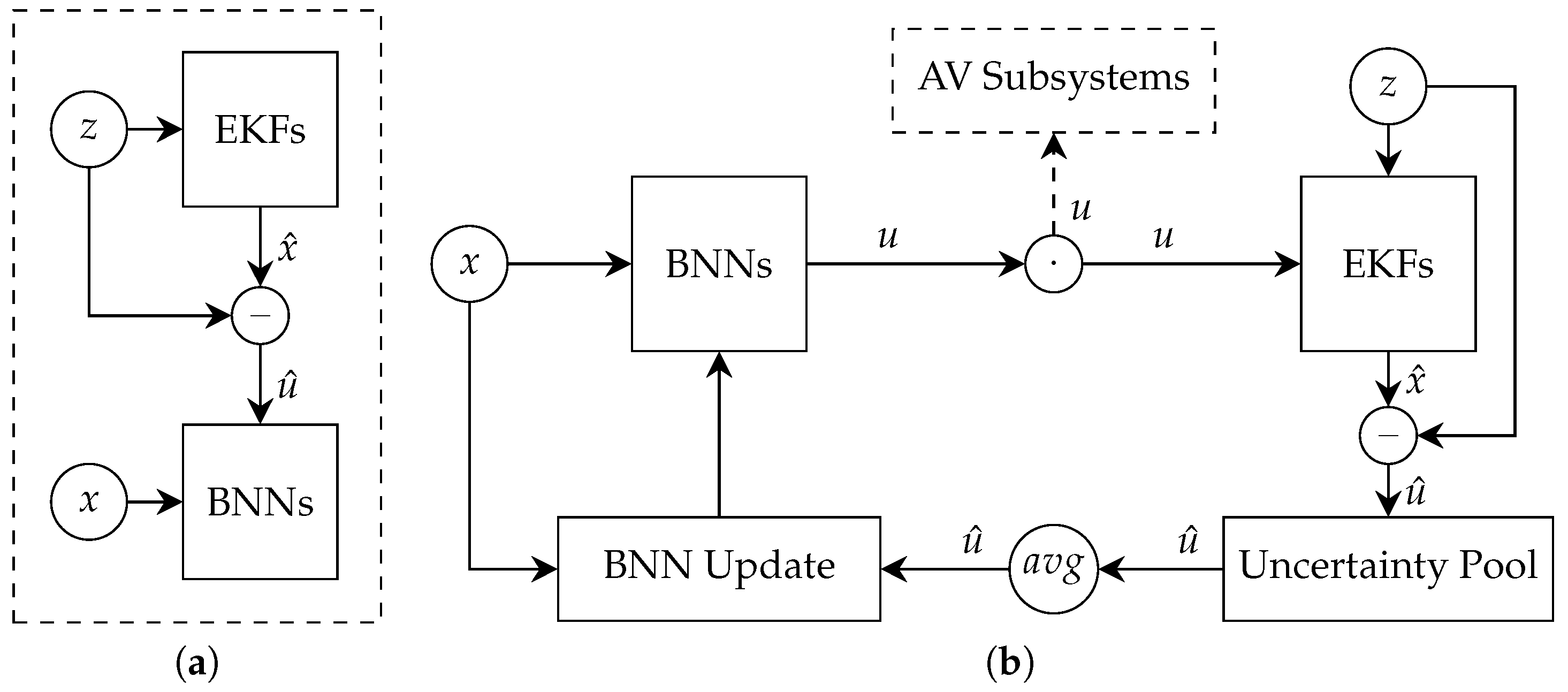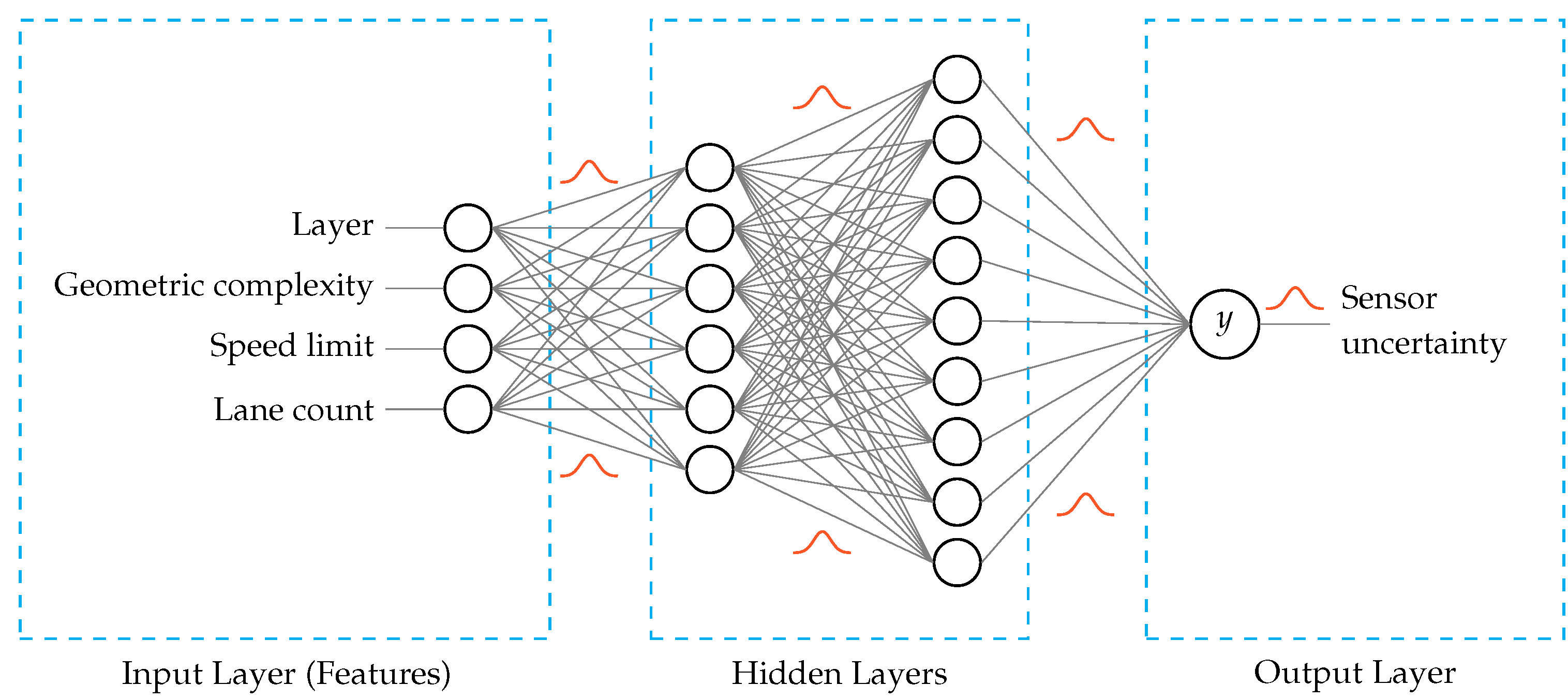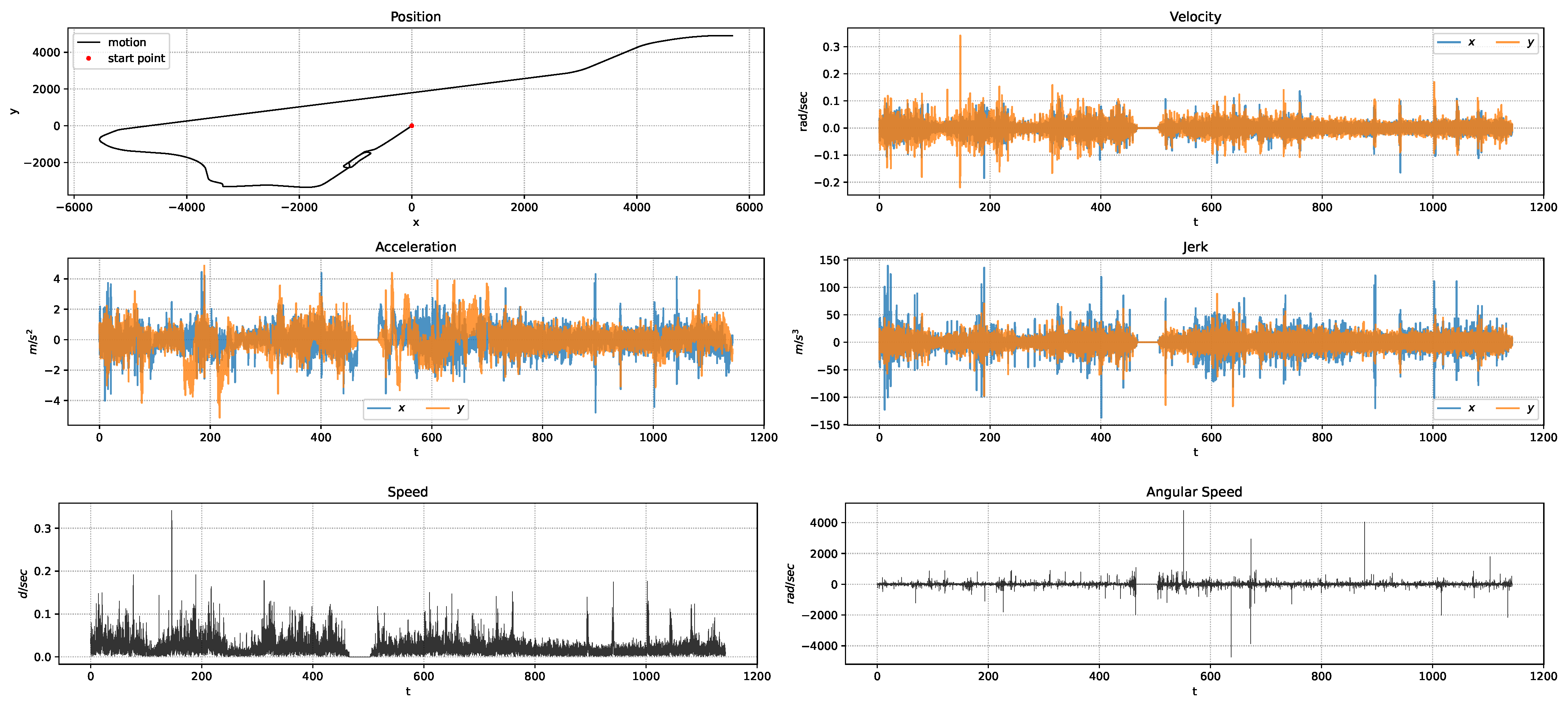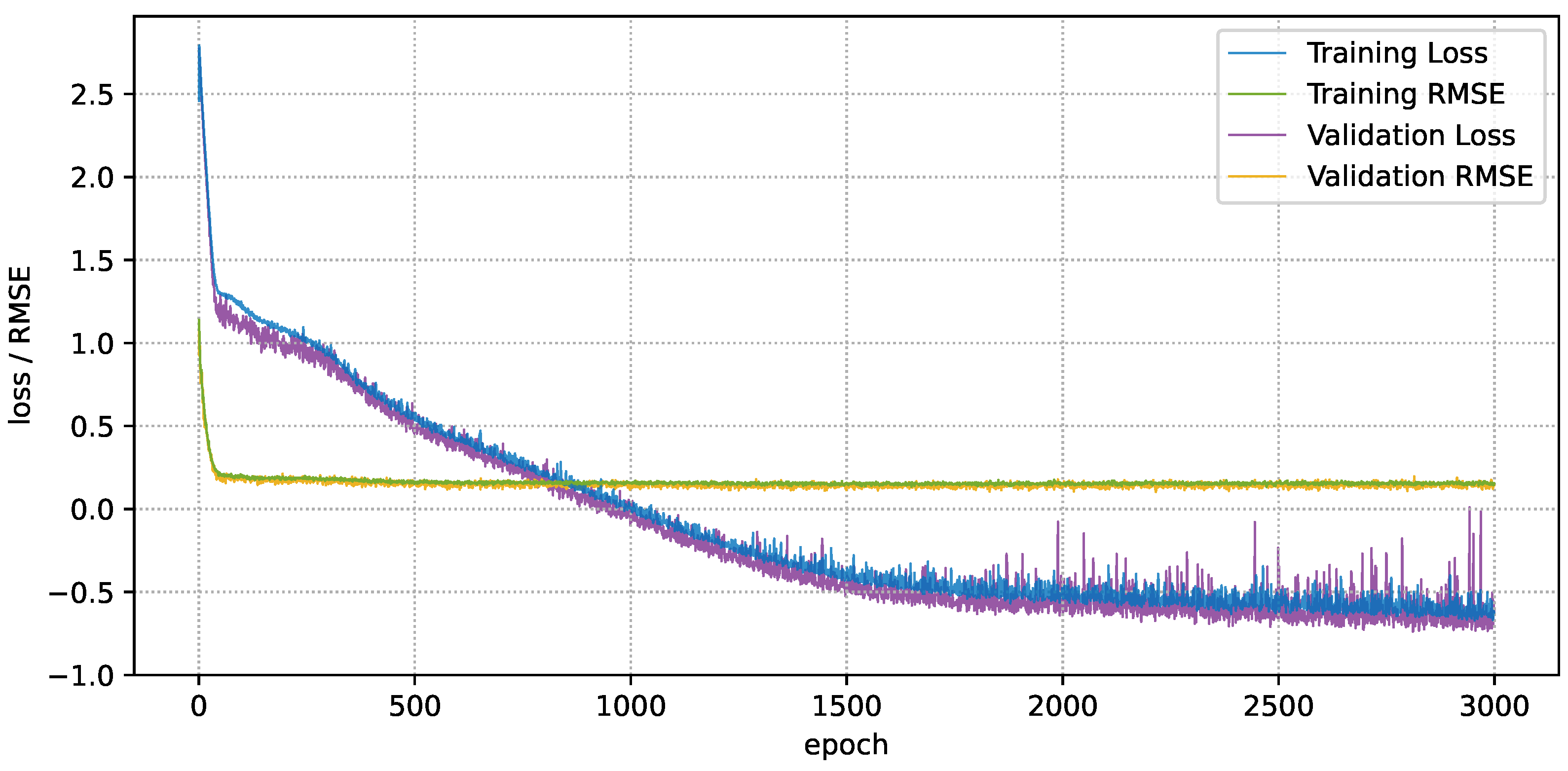Context-Aware Sensor Uncertainty Estimation for Autonomous Vehicles
Abstract
:1. Introduction
- To handle sensor uncertainty in AVs, an end-to-end context-aware approach is proposed that takes advantage of both Kalman filtering and machine learning and allows for both epistemic and aleatoric uncertainties.
- An evaluation of the proposed approach is performed using real data, and the results reveal that our approach can estimate the sensor uncertainty with a low margin of error.
2. Related Works
2.1. Data Fusion Approaches
2.2. Path Planning Approaches
2.3. Machine Learning Approaches
3. Method
3.1. Ensemble-Based Kalman Filter
3.2. Sensor Uncertainty Estimation
3.3. Bayesian Neural Networks
3.4. Pretraining Process
4. Evaluation and Discussion
5. Conclusions and Future Research
Author Contributions
Funding
Conflicts of Interest
References
- Panzieri, S.; Pascucci, F.; Ulivi, G. An outdoor navigation system using GPS and inertial platform. IEEE/ASME Trans. Mechatron. 2002, 7, 134–142. [Google Scholar] [CrossRef]
- Kaelbling, L.P.; Littman, M.L.; Cassandra, A.R. Planning and acting in partially observable stochastic domains. Artif. Intell. 1998, 101, 99–134. [Google Scholar] [CrossRef] [Green Version]
- Platt, R.; Tedrake, R.; Kaelbling, L.; Lozano-Pérez, T. Belief space planning assuming maximum likelihood observations. In Proceedings of the 6th Robotics: Science and Systems Conference, Zaragoza, Spain, 27–30 June 2010. [Google Scholar] [CrossRef]
- Urmson, C.; Anhalt, J.; Bagnell, D.; Baker, C.; Bittner, R.; Clark, M.N.; Dolan, J.; Duggins, D.; Galatali, T.; Geyer, C.; et al. Autonomous driving in urban environments: Boss and the Urban Challenge. J. Field Robot. 2008, 25, 425–466. [Google Scholar] [CrossRef] [Green Version]
- Zhang, J.; Singh, S. Visual-lidar odometry and mapping: Low-drift, robust, and fast. In Proceedings of the 2015 IEEE International Conference on Robotics and Automation (ICRA), Seattle, WA, USA, 26–30 May 2015; pp. 2174–2181. [Google Scholar] [CrossRef]
- Yan, M.; Wang, J.; Li, J.; Zhang, C. Loose coupling visual-lidar odometry by combining VISO2 and LOAM. In Proceedings of the 2017 36th Chinese Control Conference (CCC), Dalian, China, 26–28 July 2017; pp. 6841–6846. [Google Scholar] [CrossRef]
- Xiang, Z.; Yu, J.; Li, J.; Su, J. ViLiVO: Virtual LiDAR-Visual Odometry for an Autonomous Vehicle with a Multi-Camera System. In Proceedings of the 2019 IEEE/RSJ International Conference on Intelligent Robots and Systems (IROS), Macau, China, 3–8 November 2019; pp. 2486–2492. [Google Scholar] [CrossRef] [Green Version]
- Yang, Y.; Tang, D.; Wang, D.; Song, W.; Wang, J.; Fu, M. Multi-camera visual SLAM for off-road navigation. Robot. Auton. Syst. 2020, 128, 103505. [Google Scholar] [CrossRef]
- Wahyudi; Listiyana, M.S.; Sudjadi; Ngatelan. Tracking Object based on GPS and IMU Sensor. In Proceedings of the 2018 5th International Conference on Information Technology, Computer, and Electrical Engineering (ICITACEE), Semarang, Indonesia, 27–28 September 2018. [Google Scholar] [CrossRef]
- Melotti, G.; Premebida, C.; Gonçalves, N. Multimodal Deep-Learning for Object Recognition Combining Camera and LIDAR Data. In Proceedings of the 2020 IEEE International Conference on Autonomous Robot Systems and Competitions (ICARSC), Ponta Delgada, Portugal, 15–17 April 2020; pp. 177–182. [Google Scholar] [CrossRef]
- Nobis, F.; Geisslinger, M.; Weber, M.; Betz, J.; Lienkamp, M. A Deep Learning-based Radar and Camera Sensor Fusion Architecture for Object Detection. In Proceedings of the 2019 Sensor Data Fusion: Trends, Solutions, Applications (SDF), Bonn, Germany, 15–17 October 2019; pp. 1–7. [Google Scholar] [CrossRef]
- Li, Z.; Yan, M.; Jiang, W.; Xu, P. Vehicle Object Detection Based on RGB-Camera and Radar Sensor Fusion. In Proceedings of the 2019 International Joint Conference on Information, Media and Engineering (IJCIME), Osaka, Japan, 17–19 December 2019; pp. 164–169. [Google Scholar] [CrossRef]
- Asvadi, A.; Girão, P.; Peixoto, P.; Nunes, U. 3D object tracking using RGB and LIDAR data. In Proceedings of the 2016 IEEE 19th International Conference on Intelligent Transportation Systems (ITSC), Rio de Janeiro, Brazil, 1–4 November 2016; pp. 1255–1260. [Google Scholar] [CrossRef]
- Pfeuffer, A.; Dietmayer, K. Optimal Sensor Data Fusion Architecture for Object Detection in Adverse Weather Conditions. In Proceedings of the 2018 21st International Conference on Information Fusion (FUSION), Cambridge, UK, 10–13 July 2018; pp. 1–8. [Google Scholar] [CrossRef] [Green Version]
- Pfeuffer, A.; Dietmayer, K. Robust semantic segmentation in adverse weather conditions by means of sensor data fusion. In Proceedings of the 2019 22th International Conference on Information Fusion (FUSION), Ottawa, ON, Canada, 2–5 July 2019; pp. 1–8. [Google Scholar]
- Porav, H.; Bruls, T.; Newman, P. I Can See Clearly Now: Image Restoration via De-Raining. In Proceedings of the 2019 International Conference on Robotics and Automation (ICRA), Montreal, QC, Canada, 20–24 May 2019; pp. 7087–7093. [Google Scholar] [CrossRef] [Green Version]
- Sakaridis, C.; Dai, D.; Van Gool, L. Semantic Foggy Scene Understanding with Synthetic Data. Int. J. Comput. Vis. 2018, 126, 973–992. [Google Scholar] [CrossRef] [Green Version]
- Piewak, F.; Pinggera, P.; Schafer, M.; Peter, D.; Schwarz, B.; Schneider, N.; Enzweiler, M.; Pfeiffer, D.; Zollner, M. Boosting LiDAR-based Semantic Labeling by Cross-Modal Training Data Generation. In Proceedings of the European Conference on Computer Vision (ECCV) Workshops, Munich, Germany, 8–14 September 2018. [Google Scholar]
- Park, S.J.; Hong, K.S.; Lee, S. RDFNet: RGB-D Multi-Level Residual Feature Fusion for Indoor Semantic Segmentation. In Proceedings of the IEEE International Conference on Computer Vision (ICCV), Venice, Italy, 22–29 October 2017. [Google Scholar]
- Hazirbas, C.; Ma, L.; Domokos, C.; Cremers, D. FuseNet: Incorporating Depth into Semantic Segmentation via Fusion-Based CNN Architecture. In Computer Vision—ACCV 2016; Lai, S.H., Lepetit, V., Nishino, K., Sato, Y., Eds.; Springer International Publishing: Cham, Switzerland, 2017; pp. 213–228. [Google Scholar]
- Caltagirone, L.; Scheidegger, S.; Svensson, L.; Wahde, M. Fast LIDAR-based road detection using fully convolutional neural networks. In Proceedings of the 2017 IEEE Intelligent Vehicles Symposium (IV), Los Angeles, CA, USA, 11–14 June 2017; pp. 1019–1024. [Google Scholar] [CrossRef] [Green Version]
- Fu, C.; Sarabakha, A.; Kayacan, E.; Wagner, C.; John, R.; Garibaldi, J.M. Input uncertainty sensitivity enhanced nonsingleton fuzzy logic controllers for long-term navigation of quadrotor UAVs. IEEE/ASME Trans. Mechatron. 2018, 23, 725–734. [Google Scholar] [CrossRef]
- Foresti, G.L.; Regazzoni, C.S. Multisensor data fusion for autonomous vehicle navigation in risky environments. IEEE Trans. Veh. Technol. 2002, 51, 1165–1185. [Google Scholar] [CrossRef]
- Hossein, T.N.N.; Mita, S.; Long, H. Multi-sensor data fusion for autonomous vehicle navigation through adaptive particle filter. In Proceedings of the 2010 IEEE Intelligent Vehicles Symposium, La Jolla, CA, USA, 21–24 June 2010; pp. 752–759. [Google Scholar] [CrossRef]
- Smallwood, R.D.; Sondik, E.J. The optimal control of partially observable Markov processes over a finite horizon. Oper. Res. 1973, 21, 1071–1088. [Google Scholar] [CrossRef]
- Sondik, E.J. The optimal control of partially observable Markov processes over the infinite horizon: Discounted costs. Oper. Res. 1978, 26, 282–304. [Google Scholar] [CrossRef]
- Kavraki, L.E.; Švestka, P.; Latombe, J.C.; Overmars, M.H. Probabilistic roadmaps for path planning in high-dimensional configuration spaces. IEEE Trans. Robot. Autom. 1996, 12, 566–580. [Google Scholar] [CrossRef] [Green Version]
- LaValle, S.M.; Kuffner, J.J. Randomized kinodynamic planning. Int. J. Robot. Res. 2001, 20, 378–400. [Google Scholar] [CrossRef]
- Prentice, S.; Roy, N. The belief roadmap: Efficient planning in belief space by factoring the covariance. Int. J. Robot. Res. 2009, 28, 1448–1465. [Google Scholar] [CrossRef]
- Stilman, M.; Schamburek, J.U.; Kuffner, J.; Asfour, T. Manipulation Planning Among Movable Obstacles. In Proceedings of the 2007 IEEE International Conference on Robotics and Automation, Rome, Italy, 10–14 April 2007; pp. 3327–3332. [Google Scholar] [CrossRef]
- Berenson, D.; Kuffner, J.; Choset, H. An optimization approach to planning for mobile manipulation. In Proceedings of the 2008 IEEE International Conference on Robotics and Automation, Pasadena, CA, USA, 19–23 May 2008; pp. 1187–1192. [Google Scholar] [CrossRef]
- Yershova, A.; LaValle, S.M. Improving Motion-Planning Algorithms by Efficient Nearest-Neighbor Searching. IEEE Trans. Robot. 2007, 23, 151–157. [Google Scholar] [CrossRef]
- Koyuncu, E.; Ure, N.K.; Inalhan, G. Integration of Path/Maneuver Planning in Complex Environments for Agile Maneuvering UCAVs. J. Intell. Robot. Syst. 2009, 57, 143. [Google Scholar] [CrossRef]
- Luders, B.D.; Karaman, S.; Frazzoli, E.; How, J.P. Bounds on tracking error using closed-loop rapidly-exploring random trees. In Proceedings of the 2010 American Control Conference, Baltimore, MD, USA, 30 June–2 July 2010; pp. 5406–5412. [Google Scholar] [CrossRef]
- Tedrake, R.; Manchester, I.R.; Tobenkin, M.; Roberts, J.W. LQR-trees: Feedback Motion Planning via Sums-of-Squares Verification. Int. J. Robot. Res. 2010, 29, 1038–1052. [Google Scholar] [CrossRef] [Green Version]
- Van Den Berg, J.; Abbeel, P.; Goldberg, K. LQG-MP: Optimized path planning for robots with motion uncertainty and imperfect state information. Int. J. Robot. Res. 2011, 30, 895–913. [Google Scholar] [CrossRef]
- Bry, A.; Roy, N. Rapidly-exploring random belief trees for motion planning under uncertainty. In Proceedings of the 2011 IEEE International Conference on Robotics and Automation, Shanghai, China, 9–13 May 2011; pp. 723–730. [Google Scholar]
- Van Den Berg, J.; Patil, S.; Alterovitz, R. Motion planning under uncertainty using iterative local optimization in belief space. Int. J. Robot. Res. 2012, 31, 1263–1278. [Google Scholar] [CrossRef]
- Sun, W.; van den Berg, J.; Alterovitz, R. Stochastic extended LQR for optimization-based motion planning under uncertainty. IEEE Trans. Autom. Sci. Eng. 2016, 13, 437–447. [Google Scholar] [CrossRef] [Green Version]
- Alharbi, M.; Karimi, H.A. A global path planner for safe navigation of autonomous vehicles in uncertain environments. Sensors 2020, 20, 6103. [Google Scholar] [CrossRef] [PubMed]
- Kiureghian, A.D.; Ditlevsen, O. Aleatory or epistemic? Does it matter? Struct. Saf. 2009, 31, 105–112. [Google Scholar] [CrossRef]
- Neal, R.M. Bayesian Learning for Neural Networks; Springer Science & Business Media: New York, NY, USA, 2012; ISBN 978-1-4612-0745-0. [Google Scholar]
- MacKay, D.J.C. A Practical Bayesian Framework for Backpropagation Networks. Neural Comput. 1992, 4, 448–472. [Google Scholar] [CrossRef]
- Bishop, C.M. Bayesian Neural Networks. J. Braz. Comput. Soc. 1997, 4, 61–68. [Google Scholar] [CrossRef]
- Blei, D.M.; Kucukelbir, A.; McAuliffe, J.D. Variational Inference: A Review for Statisticians. J. Am. Stat. Assoc. 2017, 112, 859–877. [Google Scholar] [CrossRef] [Green Version]
- Graves, A. Practical variational inference for neural networks. In Proceedings of the 25th Annual Conference on Neural Information Processing Systems, Granada, Spain, 12–17 December 2011; pp. 2348–2356. [Google Scholar]
- Chang, G. Robust Kalman filtering based on Mahalanobis distance as outlier judging criterion. J. Geod. 2014, 88, 391–401. [Google Scholar] [CrossRef]
- Chang, G.; Liu, M. An adaptive fading Kalman filter based on Mahalanobis distance. Proc. Inst. Mech. Eng. Part G J. Aerosp. Eng. 2015, 229, 1114–1123. [Google Scholar] [CrossRef]
- Chollet, F. Keras. Available online: https://keras.io (accessed on 20 June 2021).
- Dillon, J.V.; Langmore, I.; Tran, D.; Brevdo, E.; Vasudevan, S.; Moore, D.; Patton, B.; Alemi, A.; Hoffman, M.; Saurous, R.A. TensorFlow Distributions. arXiv 2017, arXiv:cs.LG/1711.10604. [Google Scholar]
- Agarwal, S.; Vora, A.; Pandey, G.; Williams, W.; Kourous, H.; McBride, J. Ford Multi-AV Seasonal Dataset. Int. J. Robot. Res. 2020, 39, 1367–1376. [Google Scholar] [CrossRef]
- OpenStreetMap Contributors. Planet Dump. Available online: https://www.openstreetmap.org (accessed on 18 June 2021).
- Newson, P.; Krumm, J. Hidden Markov Map Matching Through Noise and Sparseness. In Proceedings of the 17th ACM SIGSPATIAL International Conference on Advances in Geographic Information Systems (ACM SIGSPATIAL GIS 2009), Seattle, WA, USA, 4–6 November 2009; pp. 336–343. [Google Scholar]
- Valhalla Contributors. Valhalla: Open Source Routing Engine for OpenStreetMap. Available online: https://valhalla.readthedocs.io (accessed on 18 June 2021).






| Route Features | ||||||||||||
|---|---|---|---|---|---|---|---|---|---|---|---|---|
| Acquisition Date | Vehicle | Log # | Freeway | Overpass | Tunnel | Cloudy | Sunny | Vegetation | Residential | Airport | University | Construction |
| 4 August 2017 | V2 | 1 | ✕ | ✕ | ✕ | |||||||
| 2 | ✕ | ✕ | ✕ | ✕ | ✕ | |||||||
| 3 | ✕ | ✕ | ||||||||||
| 4 | ✕ | ✕ | ✕ | |||||||||
| 5 | ✕ | ✕ | ✕ | ✕ | ||||||||
| 6 | ✕ | ✕ | ✕ | ✕ | ||||||||
| V3 | 1 | ✕ | ✕ | ✕ | ||||||||
| 2 | ✕ | ✕ | ✕ | ✕ | ✕ | |||||||
| 3 | ✕ | ✕ | ||||||||||
| 4 | ✕ | ✕ | ✕ | |||||||||
| 5 | ✕ | ✕ | ✕ | ✕ | ||||||||
| 6 | ✕ | ✕ | ✕ | ✕ | ||||||||
| 26 October 2017 | V2 | 1 | ✕ | ✕ | ✕ | ✕ | ||||||
| 2 | ✕ | ✕ | ✕ | ✕ | ✕ | ✕ | ||||||
| 3 | ✕ | ✕ | ||||||||||
| 4 | ✕ | ✕ | ✕ | |||||||||
| 5 | ✕ | ✕ | ✕ | ✕ | ||||||||
| 6 | ✕ | ✕ | ✕ | ✕ | ||||||||
Publisher’s Note: MDPI stays neutral with regard to jurisdictional claims in published maps and institutional affiliations. |
© 2021 by the authors. Licensee MDPI, Basel, Switzerland. This article is an open access article distributed under the terms and conditions of the Creative Commons Attribution (CC BY) license (https://creativecommons.org/licenses/by/4.0/).
Share and Cite
Alharbi, M.; Karimi, H.A. Context-Aware Sensor Uncertainty Estimation for Autonomous Vehicles. Vehicles 2021, 3, 721-735. https://doi.org/10.3390/vehicles3040042
Alharbi M, Karimi HA. Context-Aware Sensor Uncertainty Estimation for Autonomous Vehicles. Vehicles. 2021; 3(4):721-735. https://doi.org/10.3390/vehicles3040042
Chicago/Turabian StyleAlharbi, Mohammed, and Hassan A. Karimi. 2021. "Context-Aware Sensor Uncertainty Estimation for Autonomous Vehicles" Vehicles 3, no. 4: 721-735. https://doi.org/10.3390/vehicles3040042
APA StyleAlharbi, M., & Karimi, H. A. (2021). Context-Aware Sensor Uncertainty Estimation for Autonomous Vehicles. Vehicles, 3(4), 721-735. https://doi.org/10.3390/vehicles3040042






